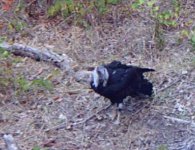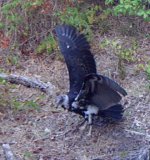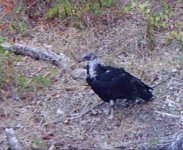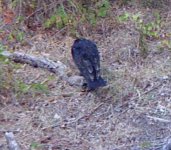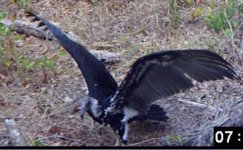Captured this image of a black and white turkey vulture, (I think) with our new game camera. Lots of turkey vultures around here, but I've never seen one with white plumage like this. Could it be an immature turkey vulture? It has white fuzzy down around its head and neck. Thanks!
-
Welcome to BirdForum, the internet's largest birding community with thousands of members from all over the world. The forums are dedicated to wild birds, birding, binoculars and equipment and all that goes with it.
Please register for an account to take part in the discussions in the forum, post your pictures in the gallery and more.
You are using an out of date browser. It may not display this or other websites correctly.
You should upgrade or use an alternative browser.
You should upgrade or use an alternative browser.
East Texas USA (1 Viewer)
- Thread starter JB00
- Start date
More options
Who Replied?Looks like you've got yourself a Black Vulture
Hi there and a warm welcome to you from those of us on staff here at BirdForum :t:
Hi there, thanks for the warm welcome. This bird has a lot of white plummage on it. The head don't look like a Black Vulture's head. I've got the videos uploading to Youtube right now. Here:
http://www.youtube.com/watch?v=1A7IPcYmYo4
It's a young Black Vulture with some retained white down feathers. The legs are gray, the newer feathers are all blackish, and the head is black; all are Black Vulture features. The bill appears all dark, which is a character of recently fledged birds.
Ok, Thanks!
MLoyko
d[-_-]b
This is saying Turkey Vulture to me, I mean it does look dark but I'm not completely sold if sold at all on Black Vulture. Tail looks too long to be Black. The head resembles TV to me and also the under wing matches TV for me as well.
http://www.flickr.com/photos/frozenintimephotosbymarianne/456903534/ a comparison I found.
I could be wrong just stating what I see
http://www.flickr.com/photos/frozenintimephotosbymarianne/456903534/ a comparison I found.
I could be wrong just stating what I see
Last edited:
Microtus
Maryland USA (he/him)

The wingtips fall short of the tail tip (where the feathers appear to be of fairly equal length), which I would not expect for a Turkey Vulture. But, I agree that the underwing with its lighter flight feathers does look better for Turkey.
On the other hand, the overall appearance of the upperparts feathers are pretty uniformly blackish, darker than I would expect on eve a young Turkey Vulture. I realize that lighting and exposure factors may make this bird look darker than it is.
I move into the undecided camp right now as I finish sipping my tea this morning.
On the other hand, the overall appearance of the upperparts feathers are pretty uniformly blackish, darker than I would expect on eve a young Turkey Vulture. I realize that lighting and exposure factors may make this bird look darker than it is.
I move into the undecided camp right now as I finish sipping my tea this morning.
The wingtips fall short of the tail tip (where the feathers appear to be of fairly equal length), which I would not expect for a Turkey Vulture. But, I agree that the underwing with its lighter flight feathers does look better for Turkey.
On the other hand, the overall appearance of the upperparts feathers are pretty uniformly blackish, darker than I would expect on eve a young Turkey Vulture. I realize that lighting and exposure factors may make this bird look darker than it is.
I move into the undecided camp right now as I finish sipping my tea this morning.
Thank you both for the input. I have the camera in the same place, so I'll be able to get more pics of the activity there. Its nest is there below the camera, so I should be able to get mom and pop there soon. That should give final proof of the type bird this is.
The wingtips fall short of the tail tip (where the feathers appear to be of fairly equal length), which I would not expect for a Turkey Vulture. But, I agree that the underwing with its lighter flight feathers does look better for Turkey.
On the other hand, the overall appearance of the upperparts feathers are pretty uniformly blackish, darker than I would expect on eve a young Turkey Vulture. I realize that lighting and exposure factors may make this bird look darker than it is.
I move into the undecided camp right now as I finish sipping my tea this morning.
Here's another video taken the next day:
http://www.youtube.com/watch?v=CETSDn13q-c
Here's more video of the vultures. A Turkey Vulture fighting with the two young Black Vultures........
http://www.youtube.com/watch?v=FpzLYVGmgg8
Here's a Close-Up of one of the Black Vultures:
http://www.youtube.com/watch?v=xF83N294oLE
http://www.youtube.com/watch?v=FpzLYVGmgg8
Here's a Close-Up of one of the Black Vultures:
http://www.youtube.com/watch?v=xF83N294oLE
Last edited:
Here's more video of the vultures. A Turkey Vulture fighting with the two young Black Vultures........
http://www.youtube.com/watch?v=FpzLYVGmgg8
Here's a Close-Up of one of the Black Vultures:
http://www.youtube.com/watch?v=xF83N294oLE
These are all Turkey Vultures (as Matt suggested above). The "Black Vultures" are not fighting with the adult, but are its offspring being fed by the adult. The adult appears to be regurgitating food directly into the mouth of its offspring.
Best,
Jim
That's what I thought when I first saw it, then it looked too violent to be a feeding behavior. Will the young ones get red heads as they get older?
Thanks!
Jim
Yes. Young TVs have black heads that turn red as they mature. The young birds will compete to be fed by the parent first, so that may be why it looks a bit violent. A nice capture on film in any event. Not something that is often seen.
Users who are viewing this thread
Total: 2 (members: 0, guests: 2)




